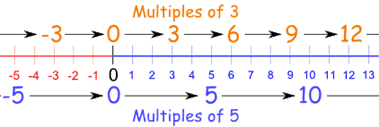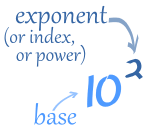Factor | |

Factors are numbers you can multiply together to get another number:
Example: 2 and 3 are factors of 6, because 2 × 3 = 6. | |
Multiple | more ... | |||

The result of multiplying a number by an integer (not a fraction).
Examples: 12 is a multiple of 3, because 3 × 4 = 12 -6 is a multiple of 3, because 3 × -2 = -6 But 7 is NOT a multiple of 3 Index Notation
(Note: Index and Power mean the same things as Exponent)
Example: 103 = 10 × 10 × 10 = 1,000
Example: 104 = 10 × 10 × 10 × 10 = 10,000
| ||||
Prime Factorization
"Prime Factorization" is finding which prime numbers multiply together to make the original number.
Here are some examples:
Example 1: What are the prime factors of 12 ?
It is best to start working from the smallest prime number, which is 2, so let's check:
12 ÷ 2 = 6
Yes, it divided evenly by 2. We have taken the first step!
But 6 is not a prime number, so we need to go further. Let's try 2 again:
6 ÷ 2 = 3
Yes, that worked also. And 3 is a prime number, so we have the answer:
12 = 2 × 2 × 3
As you can see, every factor is a prime number, so the answer must be right.
Note: 12 = 2 × 2 × 3 can also be written using exponents as 12 = 22 × 3

You forgot to write the source but the information is reliable and accurate.
ReplyDelete(Khairul Taufiq and Bryan Goh)
Chester, Xue Qin, Kenric (group 1)
ReplyDeleteYou could add some definition rephrased by you. Try not to use all pictures. Add some of your own words.